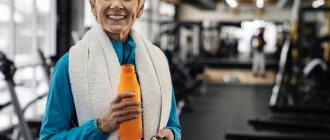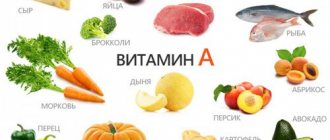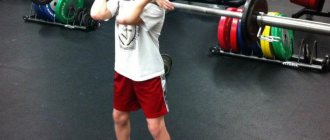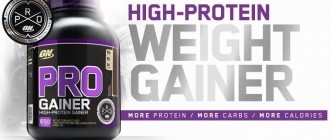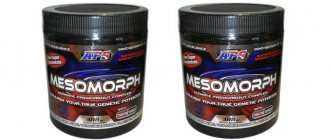Sports nutrition is one of the key aspects of preparation, which every professional and coach knows about. During high physical activity, the body consumes macro- and microelements several times faster. Ascorbic acid is especially important for athletes. The synthesis of protein, an element necessary for building muscle mass, depends on its concentration. In addition, even such seasoned people as bodybuilders are not 100% protected from the flu virus and colds, so they know very well why the body needs vitamin C. Detailed information about Ascorbic acid is here.
Ascorbic acid (vitamin C)[edit | edit code]
Vitamin C content in some foods
Ascorbic acid
(vitamin C) - an organic compound related to glucose, is one of the essential nutrients in the human diet, which is necessary for the normal functioning of connective and bone tissue. Performs the biological functions of a reducing agent and coenzyme of some metabolic processes, and is considered as an antioxidant.
Ascorbic acid in products.
Significant amounts of ascorbic acid are contained in currants, rowan berries, rose hips, as well as many vegetables and fruits; there is little of it in citrus fruits.
Effects of ascorbic acid[edit | edit code]
Formation of collagen, serotonin from tryptophan, formation of catecholamines, synthesis of corticosteroids. Ascorbic acid is also involved in the conversion of cholesterol to bile acids. Vitamin C is necessary for detoxification in hepatocytes with the participation of cytochrome P450. Restores ubiquinone and vitamin E. Stimulates the synthesis of interferon, therefore, participates in immunomodulation. Converts ferric iron obtained from plant products into divalent iron, thereby promoting its absorption.
Inhibits the glycosylation of hemoglobin, inhibits the conversion of glucose to sorbitol. Vitamin C is a powerful antioxidant that protects lipoproteins from oxidation and is an antiatherogenic molecule.
According to the results of a 2014 study published in the journal Allergy. Asthma & Clinical Immunology,” vitamin C intake helps reduce the severity of bronchospasm and respiratory symptoms (cough, wheezing, shortness of breath, shortness of breath) induced by exercise.[1] Exercise-induced bronchospasm is a transient narrowing of the bronchial lumen that occurs during or after exercise.
Vitamin C content in some foods
| Product | Vitamin C content, mg/100 g of product |
| Dry rosehip | 1000 |
| Sweet red pepper | 250 |
| Black currant | 200 |
| Sea buckthorn | 200 |
| Rowan | 160 |
| Parsley (greens) | 150 |
| Sweet green pepper | 130 |
| Needles | 130 |
| Cranberry | 100 |
| Dill | 100 |
| Oranges | 60 |
| Garden strawberries | 60 |
| Cabbage | 45 |
| Lemons | 40 |
| Beef liver | 33 |
| Fresh potatoes | 25 |
| Tomatoes | 20 |
| Apple | 20 |
| Milk | 2 |
Vitamin C. How to understand it?
V. Prozorovsky, professor, doctor of medical sciences
“Science and Life” No. 8, 2007
“What do you have here? - Smoke asked one of those lying... - Smallpox, or what? Instead of answering, the man pointed to his mouth, stretched his swollen lips with effort, and Smoke involuntarily recoiled. “Scurvy,” he said quietly to the Kid, and the patient nodded to confirm his diagnosis. “Is there enough food?” - asked the Kid. “Yeah,” replied the man from the other bed, “you can take it.” There’s plenty of food.”
D. London. Smoke and Baby. 1912
As an independent, widespread and fatal disease, scurvy (scorbut) was described in detail in the Middle Ages. It fell on people like the scourge of God during long sea voyages, protracted wars (Crusades, sieges of cities), in areas suffering from crop failure. Later, she threatened polar expeditions and gold prospectors in the northern lands with death. Now in the spring he visits the northern regions in the form of hypovitaminosis. In addition to general exhaustion, impaired strength of the vascular wall, and with it hemorrhages and bleeding, anemia, ulcerative skin lesions, tooth loss, destruction of cartilage, joint pain and other delights, with scurvy, immunity decreases and fever occurs. Since, moreover, the disease was clearly focal in nature, many considered it contagious. Others associated scurvy with poor quality food and mental depression. With partial fasting, the whole range of scurvy symptoms develops over several months. And in case of infectious diseases, especially influenza, the first signs (hemorrhages) of vitamin deficiency appear within a week.
For the first time, the presence in natural food of some special substances necessary for the life of animals was proven by the Russian pediatrician N.I. Lunin in 1881. His work (dissertation) was a major discovery, since it refuted the accepted as a law opinion of the great chemist J. Liebig (“Organic chemistry in its applications to physiology and pathology,” 1842) that proteins, fats, carbohydrates and mineral salts are quite sufficient. No, it’s not enough, more substances are needed, Lunin said, and thus opened a new era in the problem of nutrition and medicine.
Why vitamin?
In the 19th - early 20th centuries, East Asia with its Polynesian and Japanese islands was the focus of a severe endemic (inherent in a given limited area) beriberi disease (alimentary polyneuritis). It is characterized by damage to peripheral nerves, the cardiovascular system and edema, followed by muscle atrophy. Thus, in 1911 in Java and Sumatra, the mortality rate from beriberi reached 70%. In Japan, it affected mainly sailors - an average of 300 per 1000 people per year. Everyone seemed to live together on the ships, but the officers ate better and got sick less often, so the doctors assumed that the illness was somehow related to diet.
In June 1897, the Dutch doctor H. Eijkman, who served in the colonial administration, drew attention to the fact that chickens bred in the nursery at their institute in Batavia (as Jakarta was previously called) developed a disease reminiscent of beriberi in humans, — they seemed unable to walk and were constantly tumbling. Aikman noted: the disease began from the time when chickens began to be fed husked (polished) rice. He did not find microbes in their corpses, but in the nerves and spinal cord of chickens the same degeneration of nerves was noticed as in humans - the result of polyneuritis. Transferring the chickens to a normal diet led to a rapid recovery. Similar results were described in observations of the health of prisoners in different prisons. And there, transferring patients to feeding regular rice led to the elimination of the disease. For this find, H. Eikman, together with his colleague F.Kh. Hopkins received the Nobel Prize in 1929. All that was found out was that in some Batavia something necessary for health was found in the bran of rice. But they got sick all over the world, especially in the north, where there was no smell of rice, especially polished rice. So what was it?
Back in 1911, the Polish biochemist K. Funk, working in London, isolated a special dry substance from rice bran, 20 mg of which cured patients from beriberi. This substance, along with carbon and hydrogen, contained 8% nitrogen. It is for this reason that Funk proposed calling it the amine of life (vita in Latin) - a vitamin (without any letters yet). Subsequently, he isolated the same substance from yeast, milk, cow brain and lemon juice. The scientist wrote: “...to the well-known list of food elements—proteins, fats, carbohydrates, purines and mineral salts—a new group must be added, namely, “vitamins.” He called diseases caused by their absence, in particular scurvy and rickets (there was no trace of C and D yet), vitamin deficiencies. For me, it was Funk who made the real discovery of vitamins, but... the ways of the Nobel Committee are inscrutable.
Where does "S" come from?
For C to appear, A and B are first needed. In 1909, the German scientist W. Stepp reported that when mice are fed bread made with milk, the animals develop well. However, if fat is extracted from this bread using an organic solvent, the mice wither and die. If you add the extracted substance to low-fat milk bread, then they live, cheerful and vigorous. Adding vegetable oil did not have this effect, therefore, you need something fatty, but not just any fat.
Later, in 1914, the Englishmen E. McCall and M. Davis established that the necessary fat was found in butter and egg yolk. In 1919, the authors proposed to call this substance “fat-soluble factor “A”. Subsequently, it was found that the absence of factor “A” in food leads to dryness and ulceration of the cornea (xerophthalmia), and substance “A” began to be called “axerophthalmine”. A year later, it began to be used to treat retinal diseases (retina in Latin) and was already called vitamin A - retinol. That's his name now.
A year later, the same E. McCall and M. Davis discovered a “vitamin-like water-soluble substance” necessary for the growth of rats, which, alas, turned out to be identical to the vitamin used to combat beriberi. At the suggestion of the same Funk, this antipolyneuritis vitamin was designated the letter B. Less than a dozen years have passed since the number of B vitamins has increased. The first (the same one) naturally became B1, and then came B2, B3, etc. All B vitamins are united by water solubility and thermolability (sensitivity to temperature). This is how they differ from fat-soluble and heat-stable vitamin A.
A. Szent-Györgyi, who discovered vitamin C. He received the Nobel Prize in 1937 for his work on oxidation, including the discovery of ascorbic acid (image: Science and Life)
In reality, scurvy was reproduced in animals, namely guinea pigs, only in 1910 by A. Holst and J. Fröhlich. It all started with feeding experimental animals exclusively oatmeal, and then it turned out that any grain mono-diet is scurvy. Then they clarified that although the antiscorbutic factor is absent in cereal grains, it appears in green sprouts. It is present in juicy vegetables, fruits and plants in general, although in different quantities. It is also found in milk, but only in fresh milk, and is destroyed during sterilization. This is why pasteurization was invented: after it, the anti-scorbutic effect of milk decreases, but does not disappear. In 1920, I. Drummond proposed calling the antiscorbutic substance vitamin C. A very curious circumstance soon became clear - it turns out that only guinea pigs, apes and, naturally, their closest relative, humans, suffer from scurvy. In 1922, researcher N.A. Bessonov was the first to isolate an active antiscorbutic drug from white cabbage juice. Although it was not sufficiently purified, the experimental scurcutus healed in insignificant doses. (By the way, Bessonov is not even mentioned in the Great Medical Encyclopedia.) After its publication, a large series of works by many authors followed with the results of gradual purification of the drug and clarification of its properties, and only in 1933 the German biochemist F. Michel and the Hungarian scientist A. Szent -Györgyi established a formula for an antiscorbutic vitamin isolated from lemons. Szent-Györgyi later gave it the name "ascorbic acid" (he received the Nobel Prize in 1937).
The main concern of ascorbic acid
It seems natural that the main property of ascorbic acid is to prevent and heal scurvy. But only humans and others like him need it, and in all other animals (except the guinea pig), ascorbic acid is synthesized in the liver from sugars. Why? There are many reasons, but, first of all, in order to prevent a living organism from flashing a blue light, to help the necessary oxidation and to resist dangerous oxidation. We are always balancing on a razor's edge: slow oxidation is life, fast oxidation is death!
Crystals of ascorbic acid under a microscope. Photo by M. Davidson. Florida State University, USA (image: Science and Life)
All types of our activities require energy and all of it - chemical, mechanical, electrical, nervous and even mental - is born from the oxidation that oxygen carries. Not everyone can hold their breath for more than a minute. 5 minutes after oxygen supply to the brain stops, it dies. The difficulty is not only that oxygen is needed, but that it is needed only for those processes that are included in the energy metabolism chain. And these processes occur exclusively intracellularly with the participation of a number of enzymes, and the process of biological oxidation occurs not due to the direct interaction of oxygen with combustible material, but by the transfer of electrons from the oxidized substance - carbohydrates and fats - to the oxidizing agent - oxygen through a chain of enzymes. What does ascorbic acid have to do with it?
In the animal body, the chain of enzymes and substrates through which electrons are transferred, and with them oxidation energy, is long and diverse. But such a chain necessarily includes adenosine triphosphoric acid (ATP), which is the main and unique chemical battery, capable of, under the influence of enzymes and as a result of various transformations, directly transferring the energy accumulated in ATP to chemical, electrical, and mechanical processes. Carbohydrates and fats are also energy accumulators - 4.1 and 9.3 kcal/g, respectively, but without biological slow oxidation they can only burn, giving heat and light, but cannot be directly converted even into mechanical energy, not to mention mental .
However, in biological objects everything does not always proceed as it should. Oxygen can acquire not two, but one electron, which leads to oxygen instability and increased reactivity. The presence of an extra electron in an atom is conventionally indicated by a dot at the top of the element symbol.
For a number of reasons, most often external (excess ultraviolet radiation, poisoning, radiation damage, some diseases), first single activated atoms—radicals—can appear, and then their chains.
Vitamin C molecule model. Black
- carbon,
red
- oxygen,
white
- hydrogen (image: Science and Life)
And then there is a branching of the chain, which gives rise to more and more new radicals that activate individual atoms, and then large molecules. This process not only ramifies, but also accelerates. The theory of the phenomenon, both in general and in particular, including ignition and explosions, was developed by our compatriot and almost contemporary Nikolai Nikolaevich Semenov (Nobel Prize 1959).
Fortunately, in living organisms it does not come to combustion. But there are burns. A fair-haired blonde will lie down for a couple of hours under the southern sun and get a burn, sometimes to the point of blisters. For other reasons, easily oxidized fats and fat-like substances - lipids of internal organs - suffer from the rapid accumulation of atoms and molecules of active oxidants - prooxidants. Occurring in tissues, prooxidants interact primarily with the fatty membranes of the cells lining the blood vessels—endothelial cells. They oxidize and seem to foam. This is not enough; there are fat-like substances in the blood - low-density lipoproteins, which oxidize more easily than others. When oxidized, they cause destruction of endothelial cell membranes more strongly than other pro-oxidants. Cells are destroyed, and non-destructible cholesterol accumulates in the intercellular spaces. Following this comes atherosclerosis. This is not the only, but the main theory of its origin today.
By the way, polycyclic chlorinated hydrocarbons, including simple polyvinyl chloride PVC, but even simple carbon tetrachloride, as well as carbon monoxide, hydrogen sulfide and other delights of vehicle exhaust gases, can serve as initiators of the formation of active radicals.
Formula of ascorbic acid C6H8O6 - c-vitaminum
(image: Science and Life)
Skin burns under ultraviolet radiation, lungs burn when ozone is inhaled, and hydrogen peroxide generally kills all living things. Salvation from such a scourge is ascorbic acid synthesized by living organisms. That is, for all normal organisms - ascorbic acid, synthesized by themselves, and for the human body - vitamin C. This is our main defense - an antioxidant that protects the entire body and, first of all, all fat-like substances - lipids - from peroxidation. Lipid peroxidation as a biochemical concept is now so widespread that in medical literature it sometimes appears even without decoding - LEX.
Ascorbic acid is an antioxidant because it is an active reducing agent that has the ability to easily oxidize and thereby eliminate reactive oxygen species - “extinguish matches.” This reaction is not simple. Regular ascorbic acid is its reduced form. By reacting with the active oxygen and hydrogen atom, ascorbic acid itself becomes a radical, but... inactive. If the simple radical is R, the oxidized active radical is RO•2, then:
RO•2 + AK-OH = ROOH + AK-O•.
The peculiarity of the resulting AK-O radical is its low activity, which prevents its further transformations and interrupts the reaction chain, and especially its branching. Quenches the reaction. But how so? It seems like a radical is a radical. Where does the low activity of ascorbic acid come from? All acids also seem to have the same hydrogen ion. But you can eat ascorbic acid with a spoon, but it’s better to deal with nitric acid with gloves, and even under traction. Oxidized AK-O can again be converted into a reduced form, or it can be oxidized further, transforming into dehydroascorbic acid, which is then converted in complex ways into oxalic acid or partially reduced.
We should not forget that the ascorbic acid molecule is complex, and it is not just a carrier of a radical, but an enzyme. Its activity as a flame arrester is amazing - in 1 second it eliminates 1010 molecules of active hydroxyl or 107 molecules of superoxide anion radical oxygen. Alas, with food we receive mainly ascorbic acid in an already oxidized form (the longer the food is stored, the more it is oxidized). The content of ascorbic acid in main products is given in table. 1.
Table 1.
Vitamin C content in the most vitamin-rich foods (image: Science and Life)
The most delicious and healthy vitamin C preparation is holosas. These are not only rose hips, but also a choleretic agent that has never harmed anyone. And the benefits!
More than just an antioxidant
Ascorbic acid is an obligatory component (this is called a cofactor) of the activity of enzymes involved in the synthesis of nerve impulse transmitters in the brain, dopamine, adrenaline and norepinephrine, therefore, with vitamin deficiency - a lack of vitamin C - mental activity decreases and even depression develops (early spring depression).
Vitamin C activates the synthesis of collagen, the main protein of connective tissue. And if there is not enough of it, decay and collapse begins: the teeth no longer stay in their sockets, the articular cartilage softens, the sternum moves away from the ribs, the vessels do not hold blood well, hemorrhages occur in the joints, which leads to their stiffness and pain, bones break, and fractures do not occur. grow together.
Relatively recently, it was established that ascorbic acid is a participant in the synthesis of carnitine, which is a substance necessary to ensure the oxidation of fats, as they say in everyday life - combustion. But fats are a source of energy. Their deficiency causes weakness and then exhaustion. Weakness is partly associated with the development of anemia. The fact is that ascorbic acid, by taking on electrons, facilitates the absorption of iron, and therefore accelerates the formation of hemoglobin. There is no ascorbic acid - there is little iron in the blood - there is iron deficiency anemia (in the past it was called the offensive term “pale sickness”).
Previously, nitric oxide - NO - was considered only a poisonous gas, but recently it has been recognized as a participant in numerous beneficial reactions, including a substance that promotes vasodilation. R. Furchgott received the Nobel Prize for this discovery in 1998 (see “Science and Life” No. 2, 1999, No. 7, 2001). Thanks to him, the famous Viagra was created. So, ascorbic acid both promotes the synthesis and protects NO from inactivation (loss of biological activity). Thus, if not a mini-Viagra, then it is a protector against hypertension - that’s for sure. Considering that ascorbic acid also has an anti-sclerotic effect, it is clear that old people need it more than young people.
Common diseases in which hyperoxidation plays a role, in addition to atherosclerosis, include cataracts, some forms of anemia and even cancer. If not in the treatment of these diseases, then there is no doubt about the effectiveness of the preventive action of ascorbic acid.
Table 2.
Prophylactic doses of ascorbic acid (image: Science and Life)
Observations of the life activity of thousands of people indicate that regular intake of multivitamins, including ascorbic acid, from mid-winter to autumn is necessary: this protects against vitamin deficiency and improves health. But you need to take vitamins only in preventive doses (see Table 2).
How to take ascorbic acid
If the need for ascorbic acid is increased, if only because of age, then it is oxidized in larger quantities than usual, and when oxidized, it itself becomes an oxidizing agent, albeit not very active, but still with an extra electron in the outer orbit, that is dangerous. In this case, ascorbic acid must be restored, for which there are other mechanisms inherent to humans. In such situations, it is necessary to take another vitamin, which itself works and restores ascorbic acid. This is vitamin E - tocopherol (translated from Greek as “bearing childbirth”). It is named so because if it is deficient in a woman’s body, miscarriages occur. It is better to buy tocopherol in an oil solution and take 1 drop per day. Regularity is not necessary as it is deposited and used gradually.
The most “ascorbine-containing” products (image: Science and Life)
It is very significant that soon after the isolation and synthesis of ascorbic acid, the effectiveness of the powder began to be compared with lemon. And... for scurvy in pigs, lemon turned out to be much more effective. Naturally, they decided that C alone was not enough. And they also found vitamin P in lemon (from English permeability
- permeability). Permeability vitamin C and P should be taken together. Such tablets are called “askorutin”: “asko” comes from the name of the acid, and “rutin” comes from the word “ruta” - buckwheat. Vitamin P as a substance is called “quercetin”, but it has many other names (that which is obtained from lemon is called “citrine”). And all because many plant substances - flavonoids - have P-vitamin properties, but most of them are found in citrus fruits. Recently, “craftsmen” have obtained another derivative of quercetin, which is 10 times weaker than quercetin, and is sold under the name “capilar” (that’s right) for 10 times more expensive. For capillary toxicosis (inflammation of the capillary walls), the drug venorutin in ampoules is used.
Is ascorbic acid always safe?
As for the recommended (and even slightly larger) doses, they are not only useful, but sometimes necessary, since the need for ascorbic acid increases under any stress, physical and mental stress, and almost any disease.
But in addition to vitamin deficiency, there is also hypervitaminosis (excess vitamin). For some, such as vitamins A, D, K, it is a disease; for most, including vitamin C, it is a nuisance. Excess ascorbic acid can lead to its accumulation in an oxidized form, when it itself becomes an oxidant. At the same time, the absorption of glucose is impaired - pseudodiabetes occurs. A seemingly necessary reduction in blood clotting can lead to bleeding; an increased content of ascorbic acid in the blood violates the results of studies of some of its biochemical parameters, in particular glucose, bilirubin, activity of transferases (enzymes), etc.
There may be other kinds of troubles. Most of the ascorbic acid is reduced after oxidation, but a smaller part is excreted in the urine in the form of oxalic acid. Even if grams are withdrawn, but only 3-4 days - one conversation. But if the excess is constantly removed every day, and even with oxalic acid diathesis, then not only the kidneys, but also the bladder can be clogged with stones.
It has been shown that long-term (three months) intake of ascorbic acid 500 mg per day reduces the content in cells of one of the most dangerous endogenous mutagens - 8-hydroxyguanine. This is good! But taking ascorbic acid in the same dose for six months increases the content of the active mutagen 8-hydronsiadenine. But this is already bad. Although it is believed that the positive influence outweighs the negative, it is not worth the risk.
An interesting story about ascorbic acid is connected with the name of Nobel laureate L. Pauling. In the 70s of the last century, it was reported that ascorbic acid in large doses, 1–3 grams per day, taken at the first signs of acute respiratory infections, including influenza, could interrupt or at least weaken the course of the disease. Pauling, who was not only an extraordinary man, but also a passionate one, was inspired by this idea. He decided to use his own example to convince humanity that ascorbic acid prolongs life, for which he took it in large doses every day. Yes, Pauling lived to be 93 years old. But this means absolutely nothing. If this were proof enough, then my grandmother, who lived 94 years without even knowing about the existence of vitamin C, proved that it is not needed at all.
Obviously, the truth in Pauling's argument with my grandmother lies somewhere between them, but closer to my grandmother.
Literature:
1.
Davis M. et al.
Vitamin C. Chemistry and biochemistry.
- M., 1999. 2. Mussky S. A.
100 great Nobel laureates.
- M.: Veche, 2004. 475 p. 3. Heller Retal.
Vitamin C: poison, prophylactic or panacea? // TIBS. 1999. Vol. 13. P. 1007-024.
Ascorbic acid in bodybuilding[edit | edit code]
The absorption of dietary protein and the further synthesis of new protein structures, in particular in muscles, depend on vitamin C. Vitamin C is the strongest stimulator of muscle anabolism. However, you should take it wisely for bodybuilding and not exceed the dosage.
In addition, studies have found that ascorbic acid has an anti-catabolic effect by suppressing the secretion of cortisol[2][3][4] and the process of peroxidation, which has a destructive effect on muscles.[5] Therefore, vitamin C can be taken before training to reduce catabolic processes and protect muscles, and also after completing an anabolic steroid cycle, as a component of PCT. Some authors report the ability to increase testosterone production, but studies refute this.[6]
Muscle growth[edit | edit code]
In 2015, Norwegian scientists evaluated[7] the effects of taking vitamin C (500 mg) and vitamin E (117.5 mg) before and after exercise for 12 weeks on muscle growth and strength in older adults (60-81 years). Strength training took place 3 times a week, for all muscle groups. On rest days, supplements were taken in the same doses in the morning and evening. As a result, it turned out that the subjects who took these antioxidants had a lower increase in muscle mass, but no differences in the increase in strength were recorded. Scientists suggest that oxidative stress caused by exercise may be a significant contributor to muscle hypertrophy.
However, in an earlier study from 2008, another group of Canadian scientists found that vitamin C (1000 mg/day) and vitamin E (600 mg/day) caused greater gains in lean muscle mass in older adults compared to subjects. , who performed only training.[8]
Doses and regimen[edit | edit code]
The physiological need for adults is 90 mg/day, for bodybuilding 100-150 mg/day. For colds, as well as after a course of anabolic steroids to block cortisol, the dose is increased to 1000-2000 mg per day. Maximum dose 3000 mg.
Dosage form
L carnitine is produced in the form of syrup, tablets and capsules. The liquid form is sold in dark glass bottles. The syrup is packaged in 100 ml containers, which contain 10 g of the main active ingredient – levocarnitine.
Elcarnitine tablets can have different dosages - 100 mg and 500 mg. They are packaged in blisters of 10 pieces, the package can contain from 3-5 to 8 blisters. An additional ingredient here is ascorbic acid.
The medicine is also sold in capsules of 250 and 500 mg, packaged in bottles made of polymer material. There are 60, 150 pieces in one jar.
The benefits of ascorbic acid salts[edit | edit code]
Ascorbic acid is useful in all respects, except for one thing: like every acid, it destroys teeth, irritates the gastric mucosa, resulting in heartburn. We are talking about large quantities of ascorbic acid - all over the world it has long been prescribed in grams, not milligrams. Since the generally accepted dosages of ascorbic acid in the world are constantly increasing, there is a need for new drugs that do not have negative consequences.
These are mainly sodium ascorbate and calcium ascorbate - salts of ascorbic acid, which have a neutral reaction. Bifftered C-1500 is just calcium ascorbate. It differs from ascorbic acid only in that it contains calcium and has no taste. You can prepare ascorbic acid salts yourself. To obtain sodium ascorbate, ascorbic acid is mixed with ordinary baking soda (in solution) or with calcium chloride.
Links[edit | edit code]
- https://www.sciencedaily.com/releases/2014/12/141208074317.htm
- "International Journal of Sports Medicine": Vitamin C Supplementation Attenuates the Increases in Circulating Cortisol, Adrenaline and Anti-Inflammatory Polypeptides Following Ultramarathon Running, Peters EM, Anderson R, Nieman DC, Fickl H, Jogessar V. October 2001
- Effects of Ascorbic Acid on Serum Cortisol and the Testosterone: Cortisol Ratio in Junior Elite Weightlifters Marsit, Joseph L.; Conley, Michael S.; Stone, Michael H.; Fleck, Steven J.; Kearney, Jay T.; Schirmer, Ginger P.; Keith, Robert L.; Kraemer, William J.; Johnson, Robert L.
- https://www.charlespoliquin.com/Blog/tabid/130/EntryId/1562/Tip-435-Take-Vitamin-C-Post-Workout-To-Lower-Cortisol-Recover-Faster.aspx
- Effect of vitamin C supplementation on lipid peroxidation, muscle damage and inflammation after 30-min exercise at 75% VO2max. 1: J Sports Med Phys Fitness. 2008 Jun;48(2):217-24.Links
- Effects of Ascorbic Acid on Serum Cortisol and the Testosterone: Cortisol Ratio in Junior Elite Weightlifters. Original Article Journal of Strength & Conditioning Research. 12(3):179-184, August 1998.
- Bjørnsen T. et al. Vitamin C and E supplementation blunts increases in total lean body mass in elderly men after strength training //Scandinavian journal of medicine & science in sports. – 2015.
- Labonte M. et al. Effects of antioxidant supplements combined with resistance exercise on gains in fat‐free mass in healthy elderly subjects: a study pilot //Journal of the American Geriatrics Society. – 2008. – T. 56. – No. 9. – S. 1766-1768.



